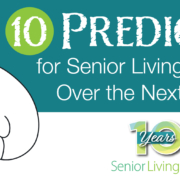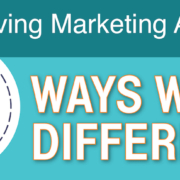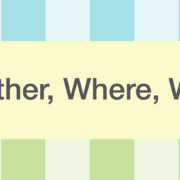10 Predictions for Senior Living Marketing Over the Next Decade
We’re in the midst of celebrating our 10th anniversary. You can catch up on some of our other anniversary-inspired posts below:
- 10 Ways Senior Living Marketing Has Changed in 10 Years
- 10 Ways We’re Not Your Average Marketing Agency
- 10 Interesting Facts About Us & Our Marketing Journey
For this post, we’ve rounded up 10 predictions in senior living marketing for the next 10 years. Some of the ideas are bigger and dreamier than others. But our team believes all have merit—and could very well happen in some fashion over the next decade or just beyond.
1. Boomer marketing will need to be segmented.
We’ve been reminding clients about this, but not enough communities are embracing the idea that Boomers should be segmented into two distinct groups: Boomers 1 and Boomers 2.
The youngest Boomers are 58, and the oldest Boomers are 76. That’s a span of nearly two decades. What a 60-year-old Boomer wants will be vastly different from someone who’s approaching 80.
- What this means for senior living marketing and sales teams: Make sure you have plenty of engaging content that speaks to both groups—and that you have an effective way to score and segment leads in your marketing automation so that you can successfully send the right message to the right Boomer at the right time.
2. Climate change will continue to enter the conversation.
From operations and infrastructure standpoints, senior living communities will need to address the climate crisis since things like more powerful hurricanes and threats of fires and floods will affect the buildings themselves. There will also be a need for clearer emergency protocols and preventive measures.
- What this means for senior living marketing and sales teams: People buying into senior living are going to increasingly care about this issue—and how it could affect their living situation. In fact, as this article reports, Boomers care about climate change as much as their younger counterparts—if not more. Communities that want to stay ahead of the curve should already be discussing messaging around green initiatives. (And urging the C-suite to start initiatives if they haven’t already.)
3. Offering plenty of variety and interesting options will matter more—much more.
The generations coming up—think Boomers and Gen X—have grown accustomed to ordering exactly what they want, when they want it. They’re not going to accept a cookie-cutter lifestyle that has few choices or limitations on customizing features and amenities.
This article from The New York Times quotes one industry expert as saying, “We have to design communities that cater to what boomers want, and that’s a difference between senior housing today and housing developed 10 or 20 years ago.”
- What this means for senior living marketing and sales teams: While this trend will affect operations and infrastructure, it will also be something marketing and sales teams will need to think about, too. Because you’re going to need to quickly convey with makes your community different from all the others—and yet also show how people can customize it to their liking.
4. More transparency will be needed on senior living websites around pricing.
Today, most communities shy away from listing prices on their senior living websites. (Or if they do, it’s either hard to find or you have to surrender your info to get it.)
We predict that over the next decade communities will need to find a way to be transparent about pricing so that no one wastes their time—prospects and community staff members alike.
Why do we predict this shift? The New York Times notes that there’s going to continue to be increasing separation between luxury senior living and more affordable options. “Specialized housing for older Americans has been around for decades. But shifting demographics are forcing the industry to diversify more rapidly across rates and services, yielding increasingly lavish residences for upper-income Americans as well as a growing number of affordable housing models.”
The article discusses some interesting experiments happening presently, like one community requiring residents to volunteer 10 hours a month in the community to help take the load off staff and to feel more connected to the community. We predict more interesting experiments like that, which brings us to some of our wilder predictions below.
- What this means for senior living marketing and sales teams: Teams will need to experiment with language and messaging around pricing discussions. This will influence so many aspects of marketing from organic search to paid ads to how you approach pricing on the website. For example, you might want to create interactive surveys that help website visitors easily self-identify whether they can afford the models that you’re specifically selling.
5. Print ads and direct mail will go away.
As we enter the next decade (the 2030s), we do predict that direct mail and print ads (and other print materials) will no longer be viable marketing channels. (Unless something unforeseen happens. We reserve the right to revise this prediction!)
Print and direct mailers still work with the Silent and Greatest Generations—and older Boomers. But think of the 58-year-olds you know today. How many of them regularly read print publications?
- What this means for senior living marketing and sales teams: Closely monitor your results with direct mailers and print ads. Don’t be afraid to pull the plug once the numbers are telling you these vehicles aren’t delivering ROI. Continue to monitor what does work with younger Boomers and Gen X (and don’t be afraid to experiment).
6. Expect to see more offers of senior living “test drives” or “free trials.”
Hey, it works for Netflix, right? And sleep trials work for mattress companies. Why shouldn’t the concept of a free trial work for senior living communities? Offering people the chance to test drive accommodations for two-week stretches might be the way to seal the deal.
After all, most communities that offer free lunches often see increased interest and higher move-in conversions from those who attend those lunches than those who don’t. So think of this idea as simply an extension of a turbocharged free lunch.
And no, it might not work for every senior living lifestyle (like memory care) or price point. But for AL and especially IL? Why not?
Now, we know there will be some kinks to work out, like making sure people don’t use the two-week trial as free lodging for a vacation. You wouldn’t offer it to just anyone, either. But for truly sales-qualified leads—we’re talking serious folks who are considering your community vs. a competitor . . . why not offer a no-obligation trial for a week or two so they can experience what life would be like?
- What this means for senior living marketing and sales teams: Our point in bringing this idea up . . . it’s going to be on marketing and sales teams to come up with some of these big, hairy, scary ideas and present them to the C-suite. And if you really want one of your wildcard ideas to happen, know that everyone on the marketing and sales teams might need to step up and participate. (Nothing is worse than someone coming up with a great idea, only for that person to walk away, because it’s on someone else to execute the great idea.)
7. Expect to see more flexible options for how, when, and where people can live. (Especially in the luxury active lifestyle space.)
Imagine a senior living community with locations in the Northeast, the South, and the West. And now imagine, as a resident, you get to split time between all three communities. Perhaps you spend your summers living in the community outside of Boston, your autumns in California, and your winters in Florida.
Who knows? Maybe a sister community will pop up in Paris, and every other spring, you get to live there. We predict more creativity and options like this, especially for the luxury active adult lifestyle.
- What this means for senior living marketing and sales teams: So much of what we’ve been discussing in this article should sound exciting to anyone who works in marketing and sales. Because historically, one of the biggest challenges has been that senior living marketing and sales teams are all essentially selling the same thing—the same floor models, the same amenities, and the same concepts (more or less). But in order to be competitive and to cater to the younger generation’s more discerning tastes, we’re going to see more differentiators—which will make it easier and more fun to market.
8. Expect to see even grander scenarios in the ultra-luxury senior living space.
The Times article we’ve been linking to throughout this blog post discusses the growing income disparity between luxury senior living and more moderate options. And we think this disparity will continue to grow.
As a result, we predict some “ultra” high-end luxury communities will come into existence, ones that offer customization to the Nth degree, amazing concierge services modeled after 5-star hotels, and lots of built-in perks. “Senior living” will become a senior living experience—with many options for what that experience can look like.
- What this means for senior living marketing and sales teams: The behind-the-scenes teams will look very different, too. The ultra-luxury model will attract people with luxury marketing backgrounds from other industries, like hotels, rather than healthcare. (This isn’t a judgment, either! Different senior living models will need very different teams supporting them.)
9. Death, dying, grief . . . these subjects will emerge from the shadows.
Some of the writers on our team—including this writer who authors most of SLS’s blog content—have often wondered why we don’t talk about death, dying, bereavement, and grieving more in senior living materials.
No, it’s not a sexy topic. Or a cheery one. But it’s necessary. People residing in senior living communities—even those on the younger end—deal with death (and long-term illnesses) regularly. Think parents, spouses, and friends. Maybe even adult children.
As this article in Psychology Today says, “We need, as a society, to acknowledge this grieving process; to talk openly to people living with a terminal condition and be kind and available. When we shun those experiencing death or loss we shut ourselves off from our more compassionate, empathetic selves and reduce our capacity to relate to those in distress.”
Now, we’re not suggesting that a community’s marketing materials will ever lead with the subject of death and dying. But as younger Boomers and Generation X come of age, we predict an easing up on the unspoken rule that talking about death is verboten.
- What this means for senior living marketing and sales teams: Writing about death in a way that people can embrace will require nuance and planning—it’s not something a writer can put together quickly. The best thing teams can do now is learn what their personas would like to know and hear about this topic. Talk to current residents. Talk to families. Talk to families who’ve recently lost a loved one who had been living in your community. What would they have wanted to be done differently? What would they have wanted to know? What materials would have helped?
10. Another pandemic? Aliens? Something else?
Back when we founded our agency in 2012, we never would have predicted the world we’re in today—a world that’s still emerging from a two-year pandemic and that’s publicly acknowledging and investigating UFOs.
Trying to predict what the world will be like ten years from now might seem like a foolish endeavor. But it’s important to dream—and to anticipate things large and small, good and bad. We do think we’ll continue to see some big marketing shifts in general—and within senior living marketing specifically.
- What this means for senior living marketing and sales teams: Stay alert. But don’t panic. From a marketing standpoint, follow reputable sources and work with people who keep their fingers on the senior living marketing pulse.
Work with us now and worry less about the future tomorrow.
Making predictions can be fun—and exhausting if you start fixating and worrying about things that haven’t happened yet. Senior living marketing can be exhausting enough on its own. Let us help. You can offload many tasks to us, and we’ll always keep you informed about the latest marketing trends we’re seeing—and if any make sense for your community.











